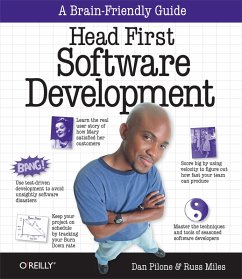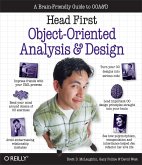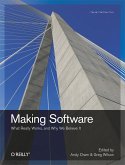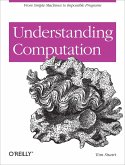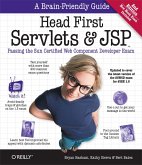Head First Software Development (eBook, ePUB)
A Learner's Companion to Software Development


Alle Infos zum eBook verschenken

Head First Software Development (eBook, ePUB)
A Learner's Companion to Software Development
- Format: ePub
- Merkliste
- Auf die Merkliste
- Bewerten Bewerten
- Teilen
- Produkt teilen
- Produkterinnerung
- Produkterinnerung

Hier können Sie sich einloggen

Bitte loggen Sie sich zunächst in Ihr Kundenkonto ein oder registrieren Sie sich bei bücher.de, um das eBook-Abo tolino select nutzen zu können.
Even the best developers have seen well-intentioned software projects fail -- often because the customer kept changing requirements, and end users didn't know how to use the software you developed. Instead of surrendering to these common problems, let Head First Software Development guide you through the best practices of software development. Before you know it, those failed projects will be a thing of the past.With its unique visually rich format, this book pulls together the hard lessons learned by expert software developers over the years. You'll gain essential information about each step…mehr
- Geräte: eReader
- mit Kopierschutz
- eBook Hilfe
- Größe: 30.13MB
- FamilySharing(5)
![Head First Object-Oriented Analysis and Design (eBook, ePUB) Head First Object-Oriented Analysis and Design (eBook, ePUB)]() Brett MclaughlinHead First Object-Oriented Analysis and Design (eBook, ePUB)30,95 €
Brett MclaughlinHead First Object-Oriented Analysis and Design (eBook, ePUB)30,95 €![Refactoring (eBook, ePUB) Refactoring (eBook, ePUB)]() Martin FowlerRefactoring (eBook, ePUB)34,95 €
Martin FowlerRefactoring (eBook, ePUB)34,95 €![Seriously Good Software (eBook, ePUB) Seriously Good Software (eBook, ePUB)]() Marco FaellaSeriously Good Software (eBook, ePUB)28,67 €
Marco FaellaSeriously Good Software (eBook, ePUB)28,67 €![Making Software (eBook, ePUB) Making Software (eBook, ePUB)]() Andy OramMaking Software (eBook, ePUB)25,95 €
Andy OramMaking Software (eBook, ePUB)25,95 €![Understanding Computation (eBook, ePUB) Understanding Computation (eBook, ePUB)]() Tom StuartUnderstanding Computation (eBook, ePUB)24,95 €
Tom StuartUnderstanding Computation (eBook, ePUB)24,95 €![Head First C (eBook, ePUB) Head First C (eBook, ePUB)]() David GriffithsHead First C (eBook, ePUB)30,95 €
David GriffithsHead First C (eBook, ePUB)30,95 €![Head First Servlets and JSP (eBook, ePUB) Head First Servlets and JSP (eBook, ePUB)]() Bryan BashamHead First Servlets and JSP (eBook, ePUB)28,95 €
Bryan BashamHead First Servlets and JSP (eBook, ePUB)28,95 €-
-
-
Dieser Download kann aus rechtlichen Gründen nur mit Rechnungsadresse in A, B, BG, CY, CZ, D, DK, EW, E, FIN, F, GR, HR, H, IRL, I, LT, L, LR, M, NL, PL, P, R, S, SLO, SK ausgeliefert werden.
Hinweis: Dieser Artikel kann nur an eine deutsche Lieferadresse ausgeliefert werden.
- Produktdetails
- Verlag: O'Reilly Media
- Seitenzahl: 498
- Erscheinungstermin: 20. Dezember 2007
- Englisch
- ISBN-13: 9781449368159
- Artikelnr.: 38312355
- Verlag: O'Reilly Media
- Seitenzahl: 498
- Erscheinungstermin: 20. Dezember 2007
- Englisch
- ISBN-13: 9781449368159
- Artikelnr.: 38312355
- Herstellerkennzeichnung Die Herstellerinformationen sind derzeit nicht verfügbar.
Praise for Head First Object-Oriented Analysis and Design
Praise for Head First Design Patterns
Author(s) of Head First Software Development
How to use this Book: Intro
Who is this book for?
We know what you're thinking
We know what your brain is thinking
Metacognition: thinking about thinking
Here's what WE did
Read Me
The technical review team
Acknowledgments
Safari® Books Online
Chapter 1: Great Software Development: Pleasing your customer
1.1 Tom's Trails is going online
1.2 Most projects have two major concerns
1.3 The Big Bang approach to development
1.4 Flash forward: two weeks later
1.5 Big bang development usually ends up in a BIG MESS
1.6 Great software development is...
1.7 Getting to the goal with ITERATION
1.8 Each iteration is a mini-project
1.9 Each iteration is QUALITY software
1.10 The customer WILL change things up
1.11 It's up to you to make adjustments
1.12 Iteration handles change automatically (well, sort of)
1.13 Your software isn't complete until it's been RELEASED
1.14 Tools for your Software Development Toolbox
Chapter 2: Gathering Requirements: Knowing what the customer wants
2.1 Orion's Orbits is modernizing
2.2 Talk to your customer to get MORE information
2.3 Bluesky with your customer
2.4 Sometimes your bluesky session looks like this...
2.5 Find out what people REALLY do
2.6 Your requirements must be CUSTOMER-oriented
2.7 Develop your requirements with customer feedback
2.8 User stories define the WHAT of your project... estimates define the WHEN
2.9 Cubicle conversation
2.10 Playing planning poker
2.11 Put assumptions on trial for their lives
2.12 A BIG user story estimate is a BAD user story estimate
2.13 The goal is convergence
2.14 The requirement to estimate iteration cycle
2.15 Finally, you're ready to estimate the whole project...
2.16 Tools for your Software Development Toolbox
Chapter 3: Project Planning: Planning for success
3.1 Customers want their software NOW!
3.2 Prioritize with the customer
3.3 We know what's in Milestone 1.0 (well, maybe)
3.4 If the features don't fit, reprioritize
3.5 More people sometimes means diminishing returns
3.6 Work your way to a reasonable Milestone 1.0
3.7 Iterations should be short and sweet
3.8 Comparing your plan to reality
3.9 Velocity accounts for overhead in your estimates
3.10 Programmers think in UTOPIAN days...
3.11 Developers think in REAL-WORLD days...
3.12 When is your iteration too long?
3.13 Deal with velocity BEFORE you break into iterations
3.14 Time to make an evaluation
3.15 Managing pissed off customers
3.16 The Big Board on your wall
3.17 How to ruin your team's lives
3.18 Tools for your Software Development Toolbox
Chapter 4: User Stories and Tasks: Getting to the real work
4.1 Introducing iSwoon
4.2 Do your tasks add up?
4.3 Plot just the work you have left
4.4 Add your tasks to your board
4.5 Start working on your tasks
4.6 A task is only in progress when it's IN PROGRESS
4.7 What if I'm working on two things at once?
4.8 Your first standup meeting...
4.9 Task 1: Create the Date class
4.10 Standup meeting: Day 5, end of Week 1...
4.11 Standup meeting: Day 2, Week 2...
4.12 You have to track unplanned tasks
4.13 Unexpected tasks raise your burn-down rate
4.14 Velocity helps, but...
4.15 We originally calculated velocity as...
4.16 So we have this much "float"...
4.17 ... but it may not be enough!
4.18 We have a lot to do...
4.19 ...but we know EXACTLY where we stand
Chapter 5: Good-Enough Design: Getting it done with great design
5.1 iSwoon is in serious trouble...
5.2 This design breaks the single responsibility principle
5.3 Spotting multiple responsibilies in your design
5.4 Going from multiple responsibilies to a single responsibility
5.5 Your design should obey the SRP, but also be DRY...
5.6 The post-refactoring standup meeting...
5.7 Unplanned tasks are still just tasks
5.8 Part of your task is the demo itself
5.9 When everything's complete, the iteration's done
Chapter 6: Version Control: Defensive development
6.1 You've got a new contract-BeatBox Pro
6.2 And now the GUI work...
6.3 And a quick test...
6.4 And Bob does the same...
6.5 Demo the new BeatBox for the customer
6.6 Standup meeting
6.7 Let's start with VERSION CONTROL
6.8 First set up your project...
6.9 ...then you can check code in and out.
6.10 Most version control tools will try and solve problems for you
6.11 The server tries to MERGE your changes
6.12 If your software can't merge the changes, it issues a conflict
6.13 Now show the customer...
6.14 More iterations, more stories...
6.15 Standup meeting
6.16 We have more than one version of our software...
6.17 Good commit messages make finding older software easier
6.18 Now you can check out Version 1.0
6.19 (Emergency) standup meeting
6.20 Tag your versions
6.21 Tags, branches, and trunks, oh my!
6.22 Fixing Version 1.0...for real this time.
6.23 We have TWO code bases now
6.24 When NOT to branch...
6.25 We fixed ersion 1...
6.26 ... and Bob finished ersion 2.0 (so he says)
6.27 Version control can't make sure your code actually works...
6.28 Tools for your Software Development Toolbox
Chapter 6 ¿: Building your Code: Insert tab a into slot b...
7.1 Developers aren't mind readers
7.2 Building your project in one step
7.3 Ant: a build tool for Java projects
7.4 Projects, properties, targets, tasks
7.5 Good build scripts...
7.6 Good build scripts go BEYOND the basics
7.7 Your build script is code, too
7.8 New developer, take two
7.9 Tools for your Software Development Toolbox
Chapter 7: Testing and Continuous Integration: Things fall apart
8.1 Things will ALWAYS go wrong...
8.2 Standup meeting
8.3 There are three ways to look at your system...
8.4 Black-box testing focuses on INPUT and OUTPUT
8.5 Grey-box testing gets you CLOSER to the code
8.6 White-box testing uses inside knowledge
8.7 Testing EVERYTHING with one step
8.8 Automate your tests with a testing framework
8.9 Use your framework to run your tests
8.10 At the wheel of CI with CruiseControl
8.11 Testing guarantees things will work... right?
8.12 Standup meeting
8.13 Testing all your code means testing EVERY BRANCH
8.14 Use a coverage report to see what's covered
8.15 Getting good coverage isn't always easy...
8.16 Standup meeting
8.17 Tools for your Software Development Toolbox
Chapter 8: Test-Driven Development: Holding your code accountable
9.1 Test FIRST, not last
9.2 So we're going to test FIRST...
9.3 Welcome to test-driven development
9.4 Your first test...
9.5 ... fails miserably.
9.6 Get your tests to GREEN
9.7 Red, green, refactor...
9.8 In TDD, tests DRIVE your implementation
9.9 Completing a task means you've got all the tests you need, and they all pass
9.10 When your tests pass, move on!
9.11 Different task, same process
9.12 Red: write (failing) tests
9.13 Green: write code to pass tests
9.14 Simplicity means avoiding dependencies
9.15 Always write testable code
9.16 When things get hard to test, examine your design
9.17 The strategy pattern provides for multiple implementations of a single interface
9.18 Keep your test code with your tests
9.19 Testing produces better code
9.20 More tests always means lots more code
9.21 Strategy patterns, loose couplings, object stand ins...
9.22 We need lots of different, but similar, objects
9.23 What if we generated objects?
9.24 A mock object stands in for real objects
9.25 Mock objects are working object stand-ins
9.26 Good software is testable...
9.27 It's not easy bein' green...
9.28 A day in the life of a test-driven developer...
9.29 Tools for your Software Development Toolbox
Chapter 9: Ending an Iteration: It's all coming together...
10.1 Your iteration is just about complete...
10.2 ... but there's lots left you could do
10.3 Standup Meeting
10.4 System testing MUST be done...
10.5 ... but WHO does system testing?
10.6 System testing depends on a complete system to test
10.7 Good system testing requires TWO iteration cycles
10.8 More iterations means more problems
10.9 The life (and death) of a bug
10.10 So you found a bug....
10.11 Anatomy of a bug report
10.12 But there's still plenty left you COULD do...
10.13 Time for the iteration review
10.14 Some iteration review questions
10.15 A GENERAL priority list for getting EXTRA things done...
10.16 Tools for your Software Development Toolbox
Chapter 10: The Next Iteration: If it ain't broke... you still better fix it
11.1 What is working software?
11.2 You need to plan for the next iteration
11.3 Velocity accounts for... the REAL WORLD
11.4 And it's STILL about the customer
11.5 Someone else's software is STILL just software
11.6 Customer approval? Check!
11.7 Testing your code
11.8 Houston, we really do have a problem...
11.9 Standup meeting
11.10 Trust NO ONE
11.11 You without your process
11.12 You with your process
Chapter 11: Bugs: Squashing bugs like a pro
12.1 First, you've got to talk to the customer
12.2 Standup meeting
12.3 Priority one: get things buildable
12.4 We could fix code...
12.5 ... but we need to fix functionality
12.6 Figure out what functionality works
12.7 NOW you know what's not working
12.8 Spike test to estimate
12.9 What do the spike test results tell you?
12.10 Your team's gut feeling matters
12.11 Give your customer the bug fix estimate
12.12 Things are looking good...
12.13 ... and you finish the iteration successfully!
12.14 AND most importantly the customer is happy
12.15 Tools for your Software Development Toolbox
Chapter 12: The Real World: Having a process in life
13.1 Pinning down a software development process
13.2 A good process delivers good software
13.3 Formal attire required...
13.4 Some additional resources...
13.5 More knowledge == better process
13.6 Tools for your Software Development Toolbox
13.7 It's time to leave a mark on the board world!
Leftovers: The top 5 topics (we didn't cover)
#1. UML class diagrams
Class diagrams show relationships
#2. Sequence diagrams
#3. User stories and use cases
#4. System tests vs. unit tests
#5. Refactoring
Techniques and Principles: Tools for the experienced software developer
Praise for Head First Object-Oriented Analysis and Design
Praise for Head First Design Patterns
Author(s) of Head First Software Development
How to use this Book: Intro
Who is this book for?
We know what you're thinking
We know what your brain is thinking
Metacognition: thinking about thinking
Here's what WE did
Read Me
The technical review team
Acknowledgments
Safari® Books Online
Chapter 1: Great Software Development: Pleasing your customer
1.1 Tom's Trails is going online
1.2 Most projects have two major concerns
1.3 The Big Bang approach to development
1.4 Flash forward: two weeks later
1.5 Big bang development usually ends up in a BIG MESS
1.6 Great software development is...
1.7 Getting to the goal with ITERATION
1.8 Each iteration is a mini-project
1.9 Each iteration is QUALITY software
1.10 The customer WILL change things up
1.11 It's up to you to make adjustments
1.12 Iteration handles change automatically (well, sort of)
1.13 Your software isn't complete until it's been RELEASED
1.14 Tools for your Software Development Toolbox
Chapter 2: Gathering Requirements: Knowing what the customer wants
2.1 Orion's Orbits is modernizing
2.2 Talk to your customer to get MORE information
2.3 Bluesky with your customer
2.4 Sometimes your bluesky session looks like this...
2.5 Find out what people REALLY do
2.6 Your requirements must be CUSTOMER-oriented
2.7 Develop your requirements with customer feedback
2.8 User stories define the WHAT of your project... estimates define the WHEN
2.9 Cubicle conversation
2.10 Playing planning poker
2.11 Put assumptions on trial for their lives
2.12 A BIG user story estimate is a BAD user story estimate
2.13 The goal is convergence
2.14 The requirement to estimate iteration cycle
2.15 Finally, you're ready to estimate the whole project...
2.16 Tools for your Software Development Toolbox
Chapter 3: Project Planning: Planning for success
3.1 Customers want their software NOW!
3.2 Prioritize with the customer
3.3 We know what's in Milestone 1.0 (well, maybe)
3.4 If the features don't fit, reprioritize
3.5 More people sometimes means diminishing returns
3.6 Work your way to a reasonable Milestone 1.0
3.7 Iterations should be short and sweet
3.8 Comparing your plan to reality
3.9 Velocity accounts for overhead in your estimates
3.10 Programmers think in UTOPIAN days...
3.11 Developers think in REAL-WORLD days...
3.12 When is your iteration too long?
3.13 Deal with velocity BEFORE you break into iterations
3.14 Time to make an evaluation
3.15 Managing pissed off customers
3.16 The Big Board on your wall
3.17 How to ruin your team's lives
3.18 Tools for your Software Development Toolbox
Chapter 4: User Stories and Tasks: Getting to the real work
4.1 Introducing iSwoon
4.2 Do your tasks add up?
4.3 Plot just the work you have left
4.4 Add your tasks to your board
4.5 Start working on your tasks
4.6 A task is only in progress when it's IN PROGRESS
4.7 What if I'm working on two things at once?
4.8 Your first standup meeting...
4.9 Task 1: Create the Date class
4.10 Standup meeting: Day 5, end of Week 1...
4.11 Standup meeting: Day 2, Week 2...
4.12 You have to track unplanned tasks
4.13 Unexpected tasks raise your burn-down rate
4.14 Velocity helps, but...
4.15 We originally calculated velocity as...
4.16 So we have this much "float"...
4.17 ... but it may not be enough!
4.18 We have a lot to do...
4.19 ...but we know EXACTLY where we stand
Chapter 5: Good-Enough Design: Getting it done with great design
5.1 iSwoon is in serious trouble...
5.2 This design breaks the single responsibility principle
5.3 Spotting multiple responsibilies in your design
5.4 Going from multiple responsibilies to a single responsibility
5.5 Your design should obey the SRP, but also be DRY...
5.6 The post-refactoring standup meeting...
5.7 Unplanned tasks are still just tasks
5.8 Part of your task is the demo itself
5.9 When everything's complete, the iteration's done
Chapter 6: Version Control: Defensive development
6.1 You've got a new contract-BeatBox Pro
6.2 And now the GUI work...
6.3 And a quick test...
6.4 And Bob does the same...
6.5 Demo the new BeatBox for the customer
6.6 Standup meeting
6.7 Let's start with VERSION CONTROL
6.8 First set up your project...
6.9 ...then you can check code in and out.
6.10 Most version control tools will try and solve problems for you
6.11 The server tries to MERGE your changes
6.12 If your software can't merge the changes, it issues a conflict
6.13 Now show the customer...
6.14 More iterations, more stories...
6.15 Standup meeting
6.16 We have more than one version of our software...
6.17 Good commit messages make finding older software easier
6.18 Now you can check out Version 1.0
6.19 (Emergency) standup meeting
6.20 Tag your versions
6.21 Tags, branches, and trunks, oh my!
6.22 Fixing Version 1.0...for real this time.
6.23 We have TWO code bases now
6.24 When NOT to branch...
6.25 We fixed ersion 1...
6.26 ... and Bob finished ersion 2.0 (so he says)
6.27 Version control can't make sure your code actually works...
6.28 Tools for your Software Development Toolbox
Chapter 6 ¿: Building your Code: Insert tab a into slot b...
7.1 Developers aren't mind readers
7.2 Building your project in one step
7.3 Ant: a build tool for Java projects
7.4 Projects, properties, targets, tasks
7.5 Good build scripts...
7.6 Good build scripts go BEYOND the basics
7.7 Your build script is code, too
7.8 New developer, take two
7.9 Tools for your Software Development Toolbox
Chapter 7: Testing and Continuous Integration: Things fall apart
8.1 Things will ALWAYS go wrong...
8.2 Standup meeting
8.3 There are three ways to look at your system...
8.4 Black-box testing focuses on INPUT and OUTPUT
8.5 Grey-box testing gets you CLOSER to the code
8.6 White-box testing uses inside knowledge
8.7 Testing EVERYTHING with one step
8.8 Automate your tests with a testing framework
8.9 Use your framework to run your tests
8.10 At the wheel of CI with CruiseControl
8.11 Testing guarantees things will work... right?
8.12 Standup meeting
8.13 Testing all your code means testing EVERY BRANCH
8.14 Use a coverage report to see what's covered
8.15 Getting good coverage isn't always easy...
8.16 Standup meeting
8.17 Tools for your Software Development Toolbox
Chapter 8: Test-Driven Development: Holding your code accountable
9.1 Test FIRST, not last
9.2 So we're going to test FIRST...
9.3 Welcome to test-driven development
9.4 Your first test...
9.5 ... fails miserably.
9.6 Get your tests to GREEN
9.7 Red, green, refactor...
9.8 In TDD, tests DRIVE your implementation
9.9 Completing a task means you've got all the tests you need, and they all pass
9.10 When your tests pass, move on!
9.11 Different task, same process
9.12 Red: write (failing) tests
9.13 Green: write code to pass tests
9.14 Simplicity means avoiding dependencies
9.15 Always write testable code
9.16 When things get hard to test, examine your design
9.17 The strategy pattern provides for multiple implementations of a single interface
9.18 Keep your test code with your tests
9.19 Testing produces better code
9.20 More tests always means lots more code
9.21 Strategy patterns, loose couplings, object stand ins...
9.22 We need lots of different, but similar, objects
9.23 What if we generated objects?
9.24 A mock object stands in for real objects
9.25 Mock objects are working object stand-ins
9.26 Good software is testable...
9.27 It's not easy bein' green...
9.28 A day in the life of a test-driven developer...
9.29 Tools for your Software Development Toolbox
Chapter 9: Ending an Iteration: It's all coming together...
10.1 Your iteration is just about complete...
10.2 ... but there's lots left you could do
10.3 Standup Meeting
10.4 System testing MUST be done...
10.5 ... but WHO does system testing?
10.6 System testing depends on a complete system to test
10.7 Good system testing requires TWO iteration cycles
10.8 More iterations means more problems
10.9 The life (and death) of a bug
10.10 So you found a bug....
10.11 Anatomy of a bug report
10.12 But there's still plenty left you COULD do...
10.13 Time for the iteration review
10.14 Some iteration review questions
10.15 A GENERAL priority list for getting EXTRA things done...
10.16 Tools for your Software Development Toolbox
Chapter 10: The Next Iteration: If it ain't broke... you still better fix it
11.1 What is working software?
11.2 You need to plan for the next iteration
11.3 Velocity accounts for... the REAL WORLD
11.4 And it's STILL about the customer
11.5 Someone else's software is STILL just software
11.6 Customer approval? Check!
11.7 Testing your code
11.8 Houston, we really do have a problem...
11.9 Standup meeting
11.10 Trust NO ONE
11.11 You without your process
11.12 You with your process
Chapter 11: Bugs: Squashing bugs like a pro
12.1 First, you've got to talk to the customer
12.2 Standup meeting
12.3 Priority one: get things buildable
12.4 We could fix code...
12.5 ... but we need to fix functionality
12.6 Figure out what functionality works
12.7 NOW you know what's not working
12.8 Spike test to estimate
12.9 What do the spike test results tell you?
12.10 Your team's gut feeling matters
12.11 Give your customer the bug fix estimate
12.12 Things are looking good...
12.13 ... and you finish the iteration successfully!
12.14 AND most importantly the customer is happy
12.15 Tools for your Software Development Toolbox
Chapter 12: The Real World: Having a process in life
13.1 Pinning down a software development process
13.2 A good process delivers good software
13.3 Formal attire required...
13.4 Some additional resources...
13.5 More knowledge == better process
13.6 Tools for your Software Development Toolbox
13.7 It's time to leave a mark on the board world!
Leftovers: The top 5 topics (we didn't cover)
#1. UML class diagrams
Class diagrams show relationships
#2. Sequence diagrams
#3. User stories and use cases
#4. System tests vs. unit tests
#5. Refactoring
Techniques and Principles: Tools for the experienced software developer
